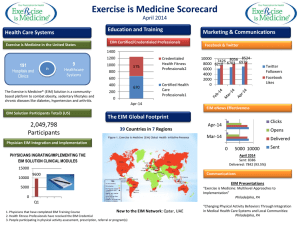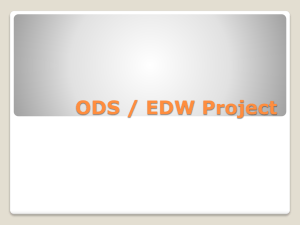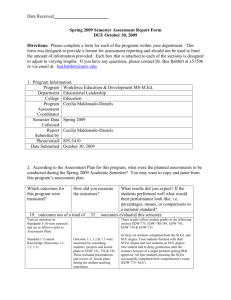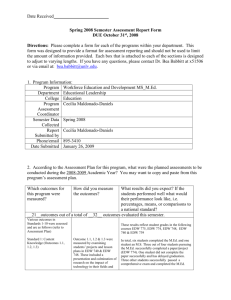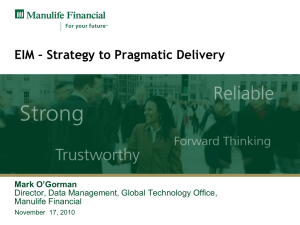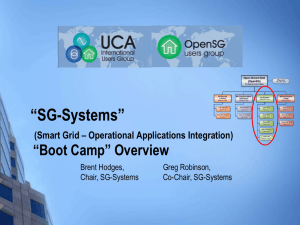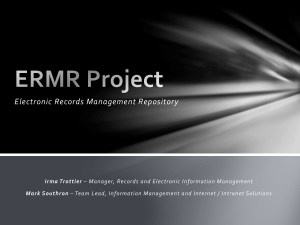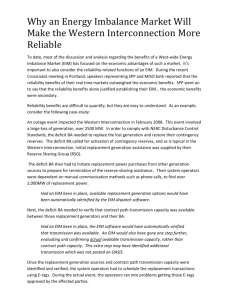Presentation - Trissential
advertisement
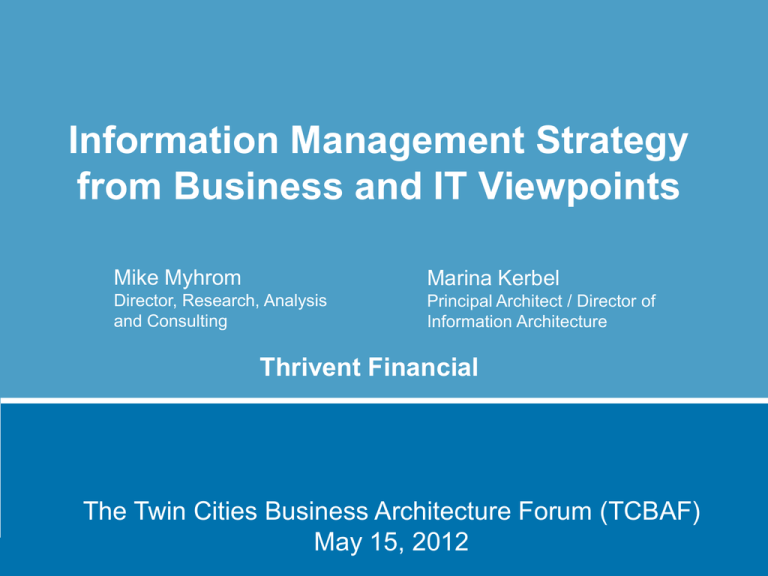
Information Management Strategy from Business and IT Viewpoints Mike Myhrom Marina Kerbel Director, Research, Analysis and Consulting Principal Architect / Director of Information Architecture Thrivent Financial 1 The Twin Cities Business Architecture Forum (TCBAF) May 15, 2012 November 2011 “Integrated BA And IA Artifacts Are Valuable — And Hard To Find” Most Organizations With Formal BA And IA Practices Link Their Architectures 2 Architecture for Business Results Business Goal: Grow Membership thru Movie Viewers Satisfaction Bus Arch: Tech. Arch: Define Movie Watching Capability & Roadmap Define tech. components that enable Wi-Fi TV streaming Info. Arch: Define Movie Catalog for Movie Subject Area and where and how viewers can access it Without a movie catalog a viewer who wanted to see 5-stars Romantic Comedy may instead get 2-stars Horror Movie 3 About Thrivent Financial … • Faith-based, not-for-profit financial services • Nearly 2.5 million members strong • Fortune 500 organization, >$73 billion in assets under management • Largest fraternal benefit society in the U.S. • Full complement of financial products and services • Mission: strengthen Christian communities by helping members be wise with money and inspiring them to live generously 4 Information Management Strategy is focused on maturing key business capabilities Example of selecting key capabilities Cross-sell to Existing Customers Initiative/Campaign ROI Calculation New Customer Acquisition High-Value Customer Retention Agent Recruiting High-Value Agent Retention Underwriting Pricing Etc. 5 Five Rules guide our work 1. Business + IT partnership. (Early and throughout.) 2. Executive support based on ROI + expanded capabilities. 3. Constant focus on supporting key business strategies. 4. A framework that’s holistic, simple, iterative. 5. Common language. partnership 6 support focus framework language Business, Technology, Data growing complexity, diversity and volume partnership 7 support focus framework language From Business to Data bringing order to complexity Can’t find data. Don’t trust it. Can’t access it. Complex, redundant, costly. Can’t leverage what’s there. partnership 8 Business Strategy Business Capabilities Enterprise Information Management (EIM) Keep making more and not sharing it. support Find data. Trust it, access it. focus Easier, more efficient, minimizing cost. Leverage what’s there. Connect, share, draw insights. framework language8 The EIM Strategy Building Blocks: subject areas & capabilities Building Blocks Subject Areas large groupings of data (such as Customer, Contract, Employee) Capabilities EIM ensures partnership 9 large groupings of functions (such as Business Intelligence, Data Warehouse, Data Services, Master Data Management / Customer Data Integration, ECM, Data Governance) clean, secure, unified, sharable data support focus available for the right people at the right time. framework language9 The EIM Building Blocks: subject areas Each subject area consists of one or more sub-areas. Used to: • Provide common framework and language across business and IT. • Establish clear boundary of data ownership and stewardship. • Identify common data needs across projects. • Provide basis for designing, managing and documenting data. partnership 10 support focus framework language10 The EIM Building Blocks: capabilities EIM ensures available for the right people at the right time. clean, secure, unified, sharable data EIM Capabilities Business Intelligence Data Warehouse & Data Marts IT Data Integration / Data Services Master Data Management (MDM) / Customer Data Integration (CDI) B U S I N E S S Enterprise Content Management (ECM) Data Governance: Metadata ,Quality, Security partnership 11 support focus framework language11 EIM Principles for subject areas and capabilities All data is classified into Subject Areas to logically divide it into manageable pieces. Each subject area has Data Owner/Stewards assigned as a critical part of the Data Governance program. Data is sourced from the System of Record or Certified Copy to ensure integrity and known quality. Each system that maintains sharable data provides Standard Interface to this data to support common data definitions and data reuse. Data Reusability Approach is used to identify common data needs across all projects so optimal enterprise solutions can be developed. Information Management Strategy that defines and promotes key principles is maintained and all projects adhere to it. partnership 12 support focus framework language EIM Principles: Each subject area has Data Owner/Stewards assigned as a critical part of the Data Governance program partnership 13 support focus framework language EIM Principle: Data Reusability Approach is used to identify common data needs across all projects Goal: Implement data solutions that are most beneficial for enterprise rather than a single project Approach: look at data needs across programs (high priority business capabilities) and develop common data solutions, prioritized by how many programs need the same data Data Requirement Matrix partnership 14 support focus framework language Roadmaps for Reuse (using EDW as Data Capability example) ROI due to reuse: • • Build sharable data by subject Cost to build for reuse = 2.5 X cost to build a silo Positive return if 3+ consumers use the same solution EDW R100 – Campaigns areas EDW R20 – Contract Term Life EDW R1– Customer Groups Compliance R1 2007 15 Compliance R2 CRM R1 2008 Fraternal R20 Marketing R30 Marketing R1 Fraternal R1 Self-Service R1 …….. Compliance R10 Marketing R40 CRM R100 Consume data by Programs (Business Capabilities) 2012 + Projects Implement Common Solutions based on Reuse roadmap Policy Admin Systems • Provide sharable Contract Data Customer Data Integration (MDM) • Provide sharable Customer data 30+ major initiatives participated in Data Reuse 16 • Integrate sharable data Many Others… CRM • Leverage sharable MDM Customer & EDW Contract data Enterprise Data Warehouse (EDW) Compliance Marketing Self Service • Leverage EDW Customer, Product, Agent data • Leverage MDM Customer, EDW Contracts • Leverage EDW Customer, Contract, Agent data EIM Story bring order to data complexity, enable business results 1 Fraternal Loyalty program rewards Members for Fraternal product ownership and engagement with organization 2 Fraternal Tools Self Service Member logs on to company website to review points earned to date, updates personal preferences thrivent.com Benefit Points Preferences 3 DW & Marts Policy Admin Contracts Compliance Package 5 Suitability Compliance Suitability analysis completed on new business contracts 17 Segmentation Marketing Marketing conducts analysis on customer information to identify members and prospects for offers and communications Sales SalesForce.com 4 CRM Financial representative responds to lead sent to SalesForce, meets with member, sells new contract Business Use of Data: Some Examples 18 Five Rules guided our work 1. Business + IT partnership. (Early and throughout.) 2. Executive support based on ROI + expanded capabilities. 3. Constant focus on supporting key business strategies. 4. A framework that’s holistic, simple, iterative. 5. Common language. 19 Information Management Strategy is focused on maturing key business capabilities Example of selecting key capabilities Cross-sell to Existing Customers Initiative/Campaign ROI Calculation New Customer Acquisition High-Value Customer Retention Agent Recruiting High-Value Agent Retention Underwriting Pricing Etc. 20 Cross-Sell Model identifies each household’s likelihood to purchase each product Each existing household assigned a probability of purchase Households rank-ordered based on probability of purchase; placed in one of twenty groups based on rank Lift for top group over 7x average 21 Household Assigned a Number of Stars for each product based on its model group Top 10% 4 stars Next 10% Next 10% Next 50% Remaining 20% 22 3 stars 2 stars 1 star 0 stars Model Output Delivered to Agents via salesforce for cross-sell success Household – Bob Jones – HHID: 12345 Variable Annuity Term Life Cash Value Life Mutual Fund Health 23 Scorecard automatically calculates and displays ROI of each campaign / event / initiative 24 New Member Acquisition Model and Pilot Campaign in progress: an example of projected ROI Data: Model Development: Printing and Mailing Costs: Management and Agent Time: $80,000 $70,000 $100,000 $200,000 Total Expense: $450,000 Member Households Contacted: 100,000 X Projected Response Rate Range: 0.3% to 1% X Average Value per Response: $1,800 = 25 Total Revenue Range: $540k to $1.8M Net Return Range: $90k to $1.35M Five Rules guided our work 1. Business+ IT partnership. (Early and throughout.) 2. Executive support based on ROI + expanded capabilities. 3. Constant focus on supporting key business strategies. 4. A framework that’s holistic, simple, iterative. 5. Common language. 26

